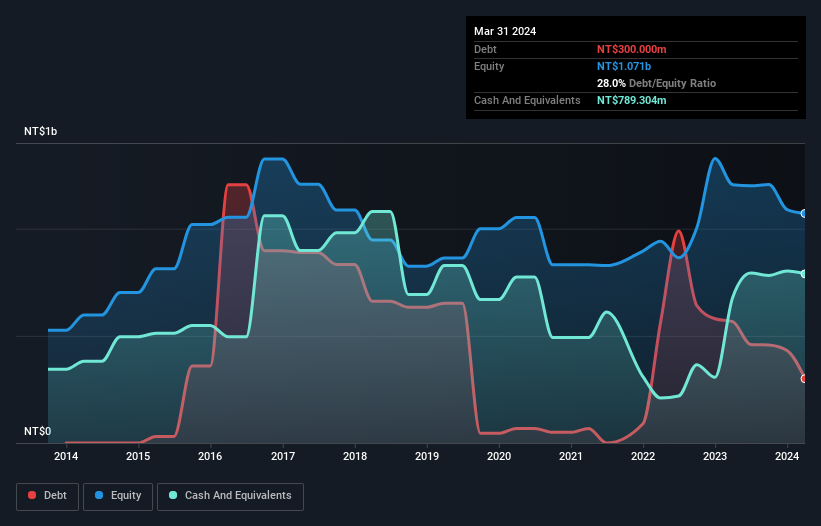- Taiwan
- /
- Communications
- /
- TWSE:3447
Health Check: How Prudently Does XAVi Technologies (TWSE:3447) Use Debt?
Some say volatility, rather than debt, is the best way to think about risk as an investor, but Warren Buffett famously said that 'Volatility is far from synonymous with risk.' It's only natural to consider a company's balance sheet when you examine how risky it is, since debt is often involved when a business collapses. We note that XAVi Technologies Corporation (TWSE:3447) does have debt on its balance sheet. But is this debt a concern to shareholders?
What Risk Does Debt Bring?
Debt assists a business until the business has trouble paying it off, either with new capital or with free cash flow. Ultimately, if the company can't fulfill its legal obligations to repay debt, shareholders could walk away with nothing. However, a more common (but still painful) scenario is that it has to raise new equity capital at a low price, thus permanently diluting shareholders. Having said that, the most common situation is where a company manages its debt reasonably well - and to its own advantage. When we examine debt levels, we first consider both cash and debt levels, together.
Check out our latest analysis for XAVi Technologies
How Much Debt Does XAVi Technologies Carry?
You can click the graphic below for the historical numbers, but it shows that XAVi Technologies had NT$300.0m of debt in March 2024, down from NT$566.5m, one year before. But on the other hand it also has NT$789.3m in cash, leading to a NT$489.3m net cash position.

A Look At XAVi Technologies' Liabilities
According to the last reported balance sheet, XAVi Technologies had liabilities of NT$1.44b due within 12 months, and liabilities of NT$16.9m due beyond 12 months. Offsetting this, it had NT$789.3m in cash and NT$564.1m in receivables that were due within 12 months. So it has liabilities totalling NT$99.9m more than its cash and near-term receivables, combined.
Of course, XAVi Technologies has a market capitalization of NT$2.33b, so these liabilities are probably manageable. Having said that, it's clear that we should continue to monitor its balance sheet, lest it change for the worse. Despite its noteworthy liabilities, XAVi Technologies boasts net cash, so it's fair to say it does not have a heavy debt load! There's no doubt that we learn most about debt from the balance sheet. But it is XAVi Technologies's earnings that will influence how the balance sheet holds up in the future. So when considering debt, it's definitely worth looking at the earnings trend. Click here for an interactive snapshot.
Over 12 months, XAVi Technologies made a loss at the EBIT level, and saw its revenue drop to NT$2.1b, which is a fall of 65%. To be frank that doesn't bode well.
So How Risky Is XAVi Technologies?
Although XAVi Technologies had an earnings before interest and tax (EBIT) loss over the last twelve months, it generated positive free cash flow of NT$538m. So although it is loss-making, it doesn't seem to have too much near-term balance sheet risk, keeping in mind the net cash. Until we see some positive EBIT, we're a bit cautious of the stock, not least because of the rather modest revenue growth. The balance sheet is clearly the area to focus on when you are analysing debt. But ultimately, every company can contain risks that exist outside of the balance sheet. These risks can be hard to spot. Every company has them, and we've spotted 1 warning sign for XAVi Technologies you should know about.
Of course, if you're the type of investor who prefers buying stocks without the burden of debt, then don't hesitate to discover our exclusive list of net cash growth stocks, today.
New: AI Stock Screener & Alerts
Our new AI Stock Screener scans the market every day to uncover opportunities.
• Dividend Powerhouses (3%+ Yield)
• Undervalued Small Caps with Insider Buying
• High growth Tech and AI Companies
Or build your own from over 50 metrics.
Have feedback on this article? Concerned about the content? Get in touch with us directly. Alternatively, email editorial-team (at) simplywallst.com.
This article by Simply Wall St is general in nature. We provide commentary based on historical data and analyst forecasts only using an unbiased methodology and our articles are not intended to be financial advice. It does not constitute a recommendation to buy or sell any stock, and does not take account of your objectives, or your financial situation. We aim to bring you long-term focused analysis driven by fundamental data. Note that our analysis may not factor in the latest price-sensitive company announcements or qualitative material. Simply Wall St has no position in any stocks mentioned.
Have feedback on this article? Concerned about the content? Get in touch with us directly. Alternatively, email editorial-team@simplywallst.com
About TWSE:3447
XAVi Technologies
Engages in the research, development, manufacture, and sale of networking communication products in Taiwan and Asia.
Excellent balance sheet with questionable track record.
Similar Companies
Market Insights
Community Narratives


Recently Updated Narratives


MINISO's fair value is projected at 26.69 with an anticipated PE ratio shift of 20x


The Quiet Giant That Became AI’s Power Grid


Nova Ljubljanska Banka d.d will expect a 11.2% revenue boost driving future growth
Popular Narratives


The company that turned a verb into a global necessity and basically runs the modern internet, digital ads, smartphones, maps, and AI.


MicroVision will explode future revenue by 380.37% with a vision towards success



